✓ Accommodations✓ Flights✓ Rental Cars
Are you planning a trip to Japan and wondering when to visit Fukuoka for the most enjoyable experience? Fukuoka is a city that shines in every season, captivating travelers with its charm.
The city’s landscape transforms with each season, from cherry blossom-covered parks in spring to vibrant autumn foliage in fall. Understanding the local weather patterns will help you plan activities that align with your preferences.
Whether you enjoy outdoor festivals or cultural indoor attractions, knowing the best time to visit will maximize your experience. This guide will walk you through the ideal months to enjoy Fukuoka’s adventures.
Understanding Fukuoka’s Climatic Diversity
To plan a weather-savvy trip to Fukuoka, it’s crucial to grasp the prefecture’s climatic diversity. Fukuoka’s climate is influenced by its geographical location, which results in varied weather conditions throughout the year.
Geographical Influences on Weather Patterns
Fukuoka’s geographical location on the northern shore of Kyushu, Japan, significantly impacts its weather patterns. The prefecture’s proximity to the Asian continent and the ocean contributes to its hot humid summer and mild winter. The varied topography, including mountains and coastal areas, also plays a role in shaping local climate conditions.
Seasonal Temperature Variations
Fukuoka experiences significant temperature variations throughout the season. Temperatures in summer can soar to nearly 95°F (35°C), while winter temperatures average around 50°F (10°C). The table below summarizes the average temperature ranges for each season.
| Season | Average High Temperature | Average Low Temperature |
|---|---|---|
| Summer | 95°F (35°C) | 75°F (24°C) |
| Winter | 50°F (10°C) | 35°F (2°C) |
| Spring | 70°F (21°C) | 50°F (10°C) |
| Autumn | 65°F (18°C) | 45°F (7°C) |
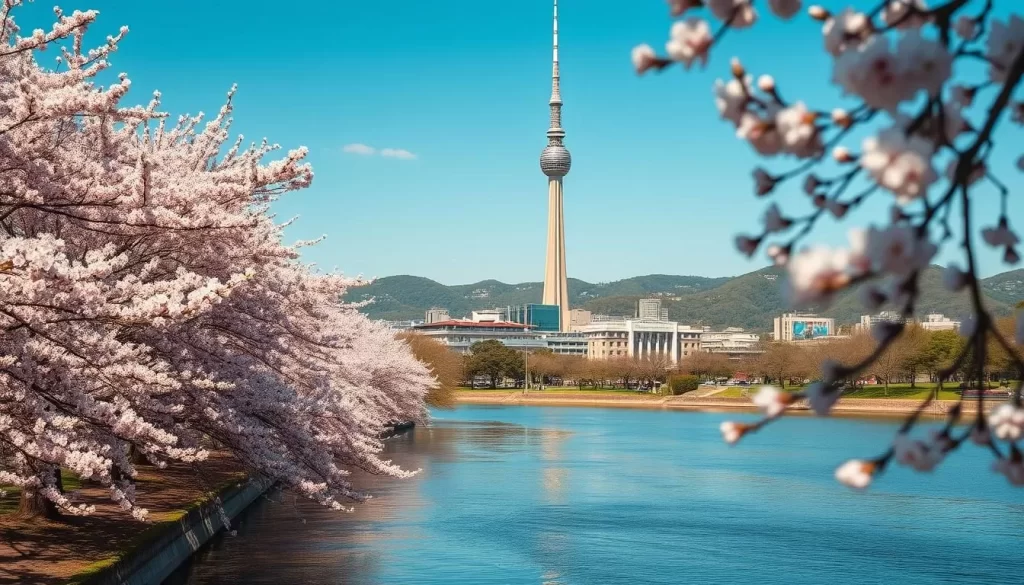
Understanding these variations is key to planning your trip and making the most out of your visit to Fukuoka.
Spring in Fukuoka: Cherry Blossoms and Mild Weather
Spring in Fukuoka is a time of renewal and celebration, marked by the iconic cherry blossoms and various festivals. As the city awakens from its winter slumber, the pleasant weather and vibrant landscapes make it an ideal destination for visitors.
March to May Weather Conditions
During spring, Fukuoka experiences mild temperatures, ranging from 10°C to 25°C (50°F to 77°F). The weather is generally pleasant, making it perfect for outdoor activities. March can be a bit chilly, but by April and May, the temperatures are quite comfortable.
Cherry Blossom Season Highlights
The cherry blossom season is a major highlight of Fukuoka’s spring. The city’s parks and gardens are filled with beautiful blooms, creating picturesque landscapes. Popular spots like Maizuru Park and Ohori Park are must-visits during this time.
Spring Festivals and Events
Fukuoka hosts numerous festivals during the spring season. The Hakata Dontaku Festival, held in early May, is one of Japan’s largest festivals, featuring colorful parades and performances. Other events include traditional tea ceremonies and local food festivals, showcasing seasonal ingredients.
| Event | Date | Description |
|---|---|---|
| Cherry Blossom Viewing | Late March to Early April | Enjoy the beautiful cherry blossoms at popular spots like Maizuru Park. |
| Hakata Dontaku Festival | Early May | One of Japan’s largest spring festivals, featuring parades and performances. |
| Traditional Tea Ceremonies | Throughout Spring | Experience traditional Japanese tea ceremonies amidst the beautiful spring landscapes. |
Summer in Fukuoka: Navigating Heat and Humidity
The arrival of summer in Fukuoka brings with it a mix of sweltering temperatures and exhilarating festivals. As you plan your visit, it’s essential to understand the climatic conditions and the vibrant cultural scene that summer has to offer.
June to August Temperature and Rainfall
Summer in Fukuoka is marked by hot and humid weather, with temperatures often reaching their peak in July and August. June to August is also a period of significant rainfall, with occasional heavy downpours. You should be prepared for the heat and humidity, staying hydrated and taking breaks in cooler environments.
Rainy Season Considerations
Fukuoka experiences its rainy season during the summer months, particularly in June and early July. While the rain can be intense, it usually doesn’t last all day. You can still enjoy outdoor activities and festivals, but it’s wise to pack accordingly and stay informed about weather forecasts.
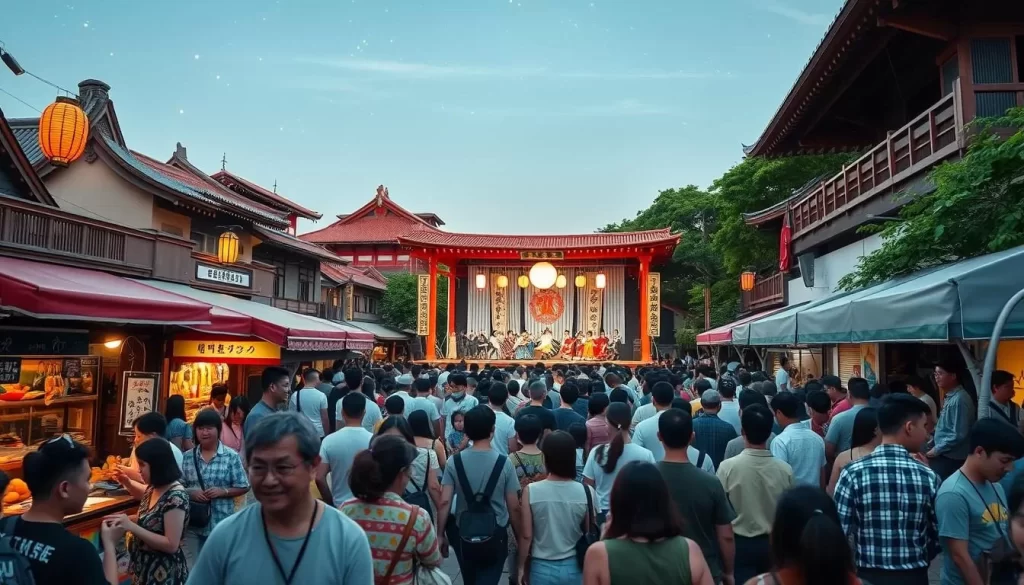
Summer Festivals and Beach Activities
Despite the heat, summer is a fantastic time to experience Fukuoka’s culture, with numerous festivals taking place throughout the city. The Hakata Gion Yamakasa Festival in July is a highlight, featuring massive decorated floats. You can also enjoy spectacular fireworks displays and visit beaches in Itoshima and along Fukuoka’s coastline for swimming and sunbathing. Traditional summer festivals offer a chance to see locals in yukata, enjoy traditional dancing, and savor seasonal treats like kakigōri.
Autumn in Fukuoka: Colorful Foliage and Comfortable Temperatures
As autumn arrives, Fukuoka transforms into a vibrant tapestry of colors and cultural experiences. The fall season brings with it a unique blend of natural beauty and cultural heritage, making it an ideal time to visit.
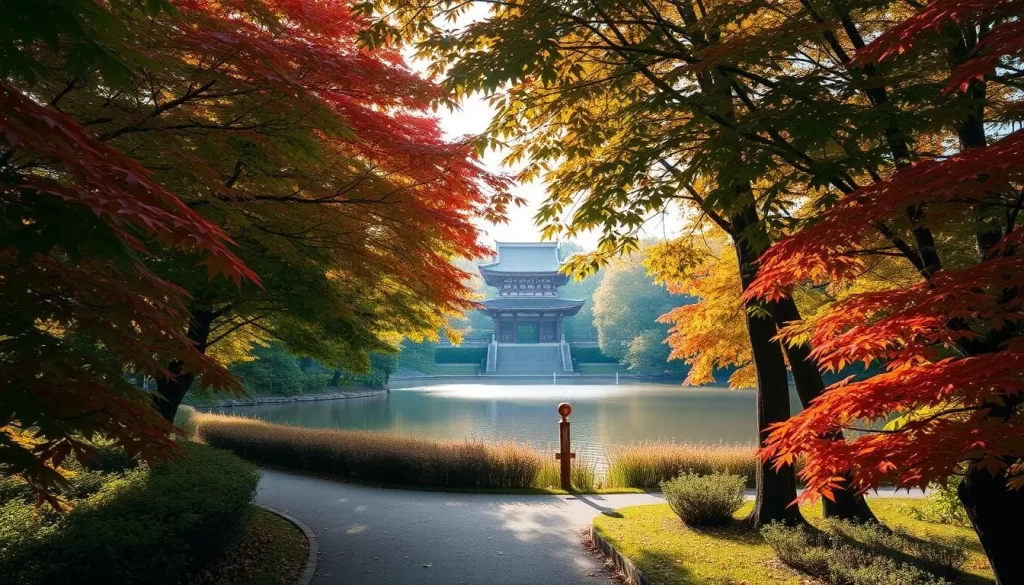
September to November Weather Patterns
From September to November, Fukuoka experiences a gradual cooling of temperatures, making the autumn season comfortable for outdoor activities. The weather is generally mild, with average highs ranging from 20°C to 25°C (68°F to 77°F), creating perfect conditions for enjoying the fall foliage and participating in outdoor festivals.
Fall Foliage Viewing Spots
Fukuoka is dotted with numerous spots ideal for viewing the fall foliage. Popular destinations include temples, gardens, and parks, which are adorned with vibrant autumn colors. Visitors can enjoy leisurely strolls while taking in the breathtaking scenery.
Autumn Harvest Festivals
The autumn season in Fukuoka is also a time for harvest festivals, celebrating the region’s agricultural bounty. Events like the Hojoya Festival at Hakozaki Shrine, wine and sake festivals, and traditional moon-viewing parties (tsukimi) offer a glimpse into the local culture. Many of these festivals feature illuminations of the fall foliage, creating magical evening experiences.
Some of the highlights of the festivals include:
- Autumn harvest festivals celebrating local specialties like Amaou strawberries, Kyushu beef, and fresh seafood.
- The Hojoya Festival, a significant autumn event with traditional performances and food stalls.
- Wine and sake festivals showcasing new releases made from the autumn harvest.
- Traditional moon-viewing parties in September, offering a uniquely Japanese cultural experience.
Visiting Fukuoka during the autumn season provides a wonderful opportunity to enjoy the natural beauty, cultural heritage, and festive atmosphere of the region. It’s a great time to explore various places and experience the local culture.
Winter in Fukuoka: Mild Climate and Seasonal Attractions
With its rare snowfall and pleasant winter weather, Fukuoka becomes a haven for travelers looking to experience Japan’s culture without the harsh cold. The city’s mild climate during winter makes it an ideal destination for those who prefer cooler temperatures without the extreme chill.
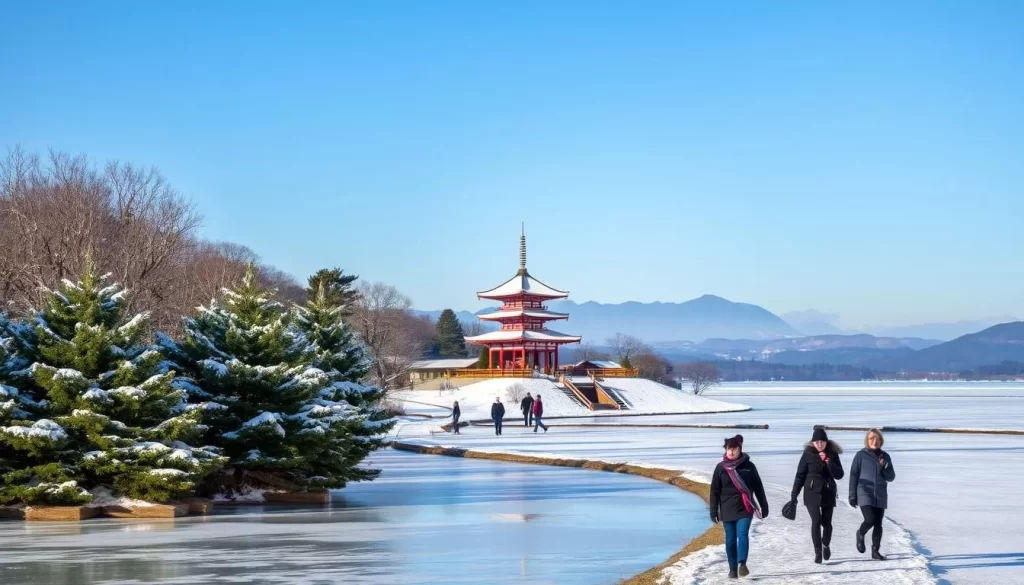
December to February Temperature Range
The winter months, from December to February, see temperatures ranging from 3°C to 12°C (37°F to 54°F). This relatively mild temperature range allows for a variety of outdoor activities, such as visiting Fukuoka’s beautiful parks and gardens, which remain serene and peaceful during this time.
Winter Illuminations and New Year Celebrations
Fukuoka comes alive during winter with beautiful illuminations and New Year (Oshogatsu) celebrations. The city’s shopping districts, such as Tenjin and Canal City, are adorned with festive lights, creating a magical atmosphere. You can experience the traditional Japanese New Year culture by visiting shrines and temples, like the Dazaifu Tenmangu Shrine, which is especially popular during this time.
Indoor Activities for Cooler Days
On cooler days, Fukuoka offers a range of indoor activities. You can explore the city’s excellent museums, such as the Kyushu National Museum and Fukuoka Asian Art Museum, which feature world-class exhibitions. Additionally, enjoying Fukuoka’s famous food culture is a must during winter, with dishes like hot pot and steaming ramen at the Nakasu yatai (food stalls) being particularly appealing. Traditional hot springs (onsen) in nearby areas like Dazaifu or Yanagawa offer relaxing bathing experiences, perfect for warming up on a chilly day.
Whether you’re interested in outdoor strolls through Fukuoka’s parks, experiencing the local food culture, or enjoying the city’s indoor attractions, winter is a great time to visit. The season’s mild climate and festive atmosphere make it an ideal period for creating unforgettable memories in this charming Japanese city.
Fukuoka Prefecture, Japan: Best Months for a Weather-Savvy Trip
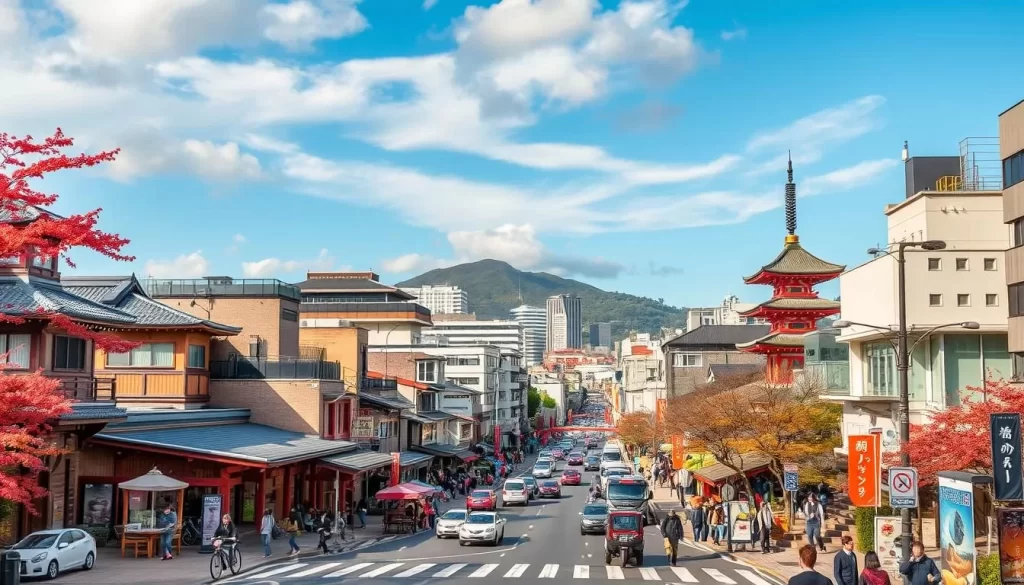
Fukuoka Prefecture is a year-round destination, but certain times are better than others for a weather-savvy trip. Understanding the best months to visit can significantly enhance your travel experience.
Ideal Months for Outdoor Exploration
The best time for outdoor activities in Fukuoka is during the spring (March to May) and autumn (September to November). These periods offer mild temperatures and comfortable weather, ideal for exploring the city’s attractions. You can enjoy pleasant days with your favorite sweaters and comfy clothes, and don’t forget good walking shoes to appreciate Fukuoka’s beauty fully.
Best Times for Cultural Experiences
For cultural experiences, consider visiting during the spring cherry blossom season or the autumn foliage. These periods are not only visually stunning but also coincide with various festivals and events. You can immerse yourself in local culture and enjoy the vibrant atmosphere that Fukuoka has to offer.
Avoiding Crowds and Peak Seasons
To avoid crowds, plan your trip during the shoulder season. Late May after Golden Week or mid-September after the summer holiday season ends are good times. Additionally, January and February (except for New Year’s week) offer lower tourist numbers and better hotel rates. Visiting on weekdays instead of weekends can also help you avoid crowds at major attractions like Dazaifu Tenmangu Shrine.
By timing your visit strategically, you can have a more relaxed and enjoyable trip to Fukuoka, making the most of your time and creating lasting memories.
Planning Your Visit: Weather-Based Itinerary Suggestions
Understanding Fukuoka’s weather patterns is key to a successful and enjoyable trip. The city’s climate varies significantly across seasons, making it crucial to plan your activities and packing accordingly.
Must-Visit Attractions by Season
Fukuoka offers a range of attractions that are best visited during specific seasons. In the spring, the city’s cherry blossoms are a major draw, with popular spots like Maizuru Park and Chikuzen-Kasuya offering breathtaking views. During summer, the beaches and summer festivals are highlights, while autumn brings vibrant fall foliage to places like Kyushu University’s Ito Campus. In winter, the city’s illuminations and New Year celebrations are not to be missed.
- Spring: Cherry blossom viewing at Maizuru Park and Chikuzen-Kasuya
- Summer: Enjoy beaches and summer festivals
- Autumn: Fall foliage at Kyushu University’s Ito Campus
- Winter: Winter illuminations and New Year celebrations
Packing Essentials for Each Season
Packing appropriately for Fukuoka’s seasons can greatly enhance your travel experience. For spring, layers are key, including light sweaters and waterproof jackets for occasional showers. In summer, lightweight, breathable clothing and UV protection are essential. Autumn requires layers for cooler mornings and evenings, while winter necessitates a medium-weight coat and warm accessories.
- Spring: Layers, waterproof jacket, comfortable shoes
- Summer: Lightweight clothing, UV protection, portable fan
- Autumn: Adjustable layers, comfortable hiking shoes
- Winter: Medium-weight coat, warm accessories, moisturizer
Regardless of the season, certain year-round essentials should always be packed, including comfortable walking shoes, a portable Wi-Fi device, a travel adapter, and a small backpack for daily excursions.
Conclusion
With its diverse climate and rich cultural heritage, Fukuoka is a city that has something to offer every kind of traveler. You can enjoy the beauty of cherry blossoms in spring, relax on the beach in summer, see the colorful fall foliage, or experience a snowy winter. Every season in Fukuoka brings something special and lasting memories.
Knowing the weather and key events in Fukuoka helps you plan a smart trip. This way, you can see and do things that match your interests for a memorable time in this lively city. Whether you’re drawn to the excitement of summer festivals, the tranquility of autumn foliage, the magic of spring blossoms, or the peaceful atmosphere of winter, Fukuoka welcomes you with seasonal charms that create lasting memories.
By understanding Fukuoka’s seasonal patterns, you can craft a trip that balances your interest in cultural immersion, natural beauty, culinary exploration, and comfortable weather conditions. Plan your visit for the best months to visit Fukuoka, or customize it to see what you like. Either way, you’ll make memories for life.
The above is subject to change.
Check back often to TRAVEL.COM for the latest travel tips and deals.






